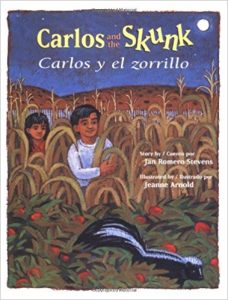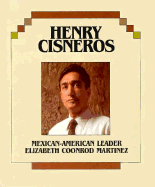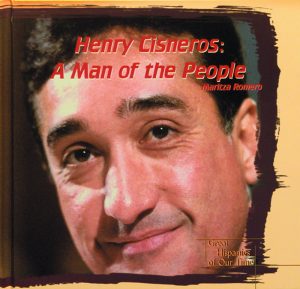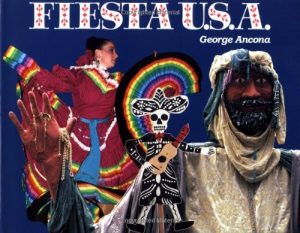 In a tribute to the customs and traditions of Latinos in the United States, engaging photographs capture four fiestas: the Day of the Dead, las Posadas, the dance of the Matachines, and Three Kings’ Day.
In a tribute to the customs and traditions of Latinos in the United States, engaging photographs capture four fiestas: the Day of the Dead, las Posadas, the dance of the Matachines, and Three Kings’ Day.
Southwest
Rattling Chains and Other Stories for Children / Ruido De Cadenas Y Otros Cuentos Para Ninos
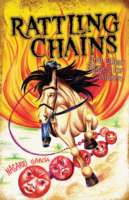
A collection of scary stories based on the lore of New Mexico, in English and in Spanish.
Carlos Y El Zorillo/ Carlos And The Skunk (Carlos Series)
He Forgot To Say Goodbye
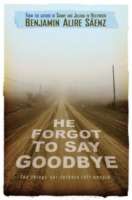
“Ramiro Lopez and Jake Upthegrove don’t appear to have much in common. Ram lives in the Mexican-American working-class barrio of El Paso called “Dizzy Land.” His brother is sinking into a world of drugs, wreaking havoc in their household. Jake is a rich West Side white boy who has developed a problem managing his anger. An only child, he is a misfit in his mother’s shallow and materialistic world. But Ram and Jake do have one thing in common: They are lost boys who have never met their fathers. This sad fact has left both of them undeniably scarred and obsessed with the men who abandoned them. As Jake and Ram overcome their suspicions of each other, they begin to move away from their loner existences and realize that they are capable of reaching out beyond their wounds and the neighborhoods that they grew up in. Their friendship becomes a healing in a world of hurt.
Case Of The Pen Gone Missing: A Mickey Rangel Mystery / El Caso De La Pluma Perdida: Coleccion Mickey Rangel, Detective Privado
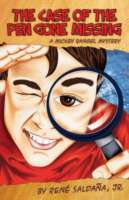
When Toots Rodriguez approaches Mickey on the playground, he knows something is up. Toots, the prettiest girl in the fifth grade, never talks to Mickey, not even when they’re assigned to work together on a class project. But Toots has come to Mickey because she’s in trouble, and he’s a detective. The real deal. He has a badge and a certificate after completing an online course two years ago. ”You have to believe me, Mickey. I didn’t take that pen. I didn’t.” When Toots shines her big green eyes on him and insists repeatedly that she’s innocent, Mickey’s intuition tells him to run fast in the opposite direction. But he’s a sucker for a pretty girl, so he takes on the case of the missing pen. Rumor has it that Toots stole Eddy’s pen. It’s not just any old pen; it’s his dad’s pen. It has the White House logo on it. Eddy’s father, a senator from South Texas, got the pen from the President of the United States when he visited the White House last year. As Mickey begins his investigation, though, all the clues point to Toots and her newly ex-boyfriend as the primary suspects. The first book in The Mickey Rangel Mystery series for intermediate readers, author and educator Rene Saldana, Jr. has crafted another appealing book for kids, and his wise-cracking, smart protagonist will appeal to even the most reluctant readers.
Henry Cisneros
The Eyes Of The Weaver: Los Ojos Del Tejedor
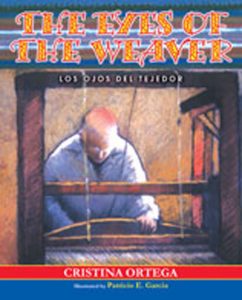 Cristina Ortega is the granddaughter of Juan Melquiades Ortega, a master weaver of northern New Mexico’s Chimayó Valley. Chimayó’s roots are in early Spanish Colonial times and has long been famous for its unique weavings. Juan M. Ortega was taught to weave by his father in the early days when weavers sheared their own sheep and spun and dyed the wool for their blankets. El Tejedor (The Weaver) continued weaving until he was one hundred years old, when his eyesight failed him. In The Eyes of the Weaver, Cristina shares her memories of visits when she was ten years old with Grandpa in the village of Chimayó, where he taught her how to weave. She also recalls how Grandma helped her husband choose color combinations for his Chimayó blankets. It was during these visits that Cristina learned how important it is for a child to listen to and learn from his or her relatives.Some of Juan M. Ortega’s weavings and tools of the trade have been included in the exhibit, “American Encounters,” at the National Museum of American History, Smithsonian Institution, in Washington, D.C.Reading level: 10 years and up
Cristina Ortega is the granddaughter of Juan Melquiades Ortega, a master weaver of northern New Mexico’s Chimayó Valley. Chimayó’s roots are in early Spanish Colonial times and has long been famous for its unique weavings. Juan M. Ortega was taught to weave by his father in the early days when weavers sheared their own sheep and spun and dyed the wool for their blankets. El Tejedor (The Weaver) continued weaving until he was one hundred years old, when his eyesight failed him. In The Eyes of the Weaver, Cristina shares her memories of visits when she was ten years old with Grandpa in the village of Chimayó, where he taught her how to weave. She also recalls how Grandma helped her husband choose color combinations for his Chimayó blankets. It was during these visits that Cristina learned how important it is for a child to listen to and learn from his or her relatives.Some of Juan M. Ortega’s weavings and tools of the trade have been included in the exhibit, “American Encounters,” at the National Museum of American History, Smithsonian Institution, in Washington, D.C.Reading level: 10 years and up
Chicken Foot Farm
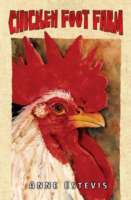
On the eve of World War II, young Alejandro comes of age on his family’s South Texas farm, known as Chicken Foot Farm because of how his mother marks her chicks. “Mama held the chick against her breast and splayed its left foot between her thumb and index finger. With her free hand she… quickly cut off the end of the chick’s shortest toe.” Rich with the customs and traditions of rural, Mexican-American life, Chicken Foot Farm depicts a multi-generational family in flux as change crawls relentlessly toward their land and lifestyle. As the seasons–and loved ones–come and go and misfortunes befall the family, Alejandro learns the lessons of life: the importance of family, honesty, hard work, and compassion. When the kitchen burns down one night, Alejandro feels they have lost something integral to their family unity. But his father promises they will build another kitchen, the new one better than the old. As Abuela Luciana ages, she begins to behave erratically, burning tortillas, forgetting to add water to the beans she is cooking, and even disappearing from the farm. She is certain someone has cursed her–put mal de ojo on her. How can the family cure her when she is the curandera, the one who has always taken care of them? Most importantly, Alejandro works hard to win his father’s approval, even though Papa generally ignores him in favor of the eldest son, Ernesto, who Papa says will inherit the farm. When Ernesto joins the Army, the family must face the possibility that he may not return as the entire country is thrown into the uncertainty of war. Following the attack on Pearl Harbor, young Alejandro notices something new in his family’s kitchen: a framed United States flag now hangs on the wall. “It’s something I can do for the war,” his Abuela Luciana tells him. Not understanding, she explains to him, “I can remind people that we are Americans.” In these poignant images of a time and place long gone, Anne Estevis sketches a tight-knit, Mexican-American community on the cusp of a new way of life as tractors replace mules and modern science competes with superstitious beliefs.
Henry Cisneros: A Man Of The People (Romero, Maritza. Great Hispanics Of Our Time.)
The Absolutely True Diary of a Part-Time Indian
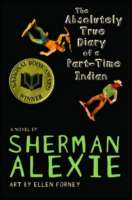
In his first book for young adults, bestselling author Sherman Alexie tells the story of Junior, a budding cartoonist growing up on the Spokane Indian Reservation. Determined to take his future into his own hands, Junior leaves his troubled school on the rez to attend an all-white farm town high school where the only other Indian is the school mascot. Heartbreaking, funny, and beautifully written, The Absolutely True Diary of a Part-Time Indian, which is based on the author’s own experiences, coupled with poignant drawings by acclaimed artist Ellen Forney, that reflect the character’s art, chronicles the contemporary adolescence of one Native American boy as he attempts to break away from the life he was destined to live.
Featured in Volume I, Issue 2 of WOW Review.

